MARIANI’SVirtual
Gourmet
July
7, 2013
NEWSLETTER

San Francisco Kitchen
Workers, circa 1900
✤✤✤
THIS WEEK
SEATTLE IS MORE
SAVORY THAN EVER
by John Mariani
NEW YORK CORNER
BEDFORD POST
INN
by John Mariani
NOTES FROM THE
WINE CELLAR
KNOW WHAT
YOU'RE PAYING FOR
by Mort Hochstein
✤✤✤
SEATTLE
IS MORE SAVORY THAN EVER
by
John Mariani

Were Seattle only
the home of Pike Place Market, it would have
legitimate claim to being one of America's great
food cities. Stretching over nine acres,
cobbled together in warrens of nooks and crannies,
up and down stairways, Pike Place seems like a
market designed by Jorge Luis Borges.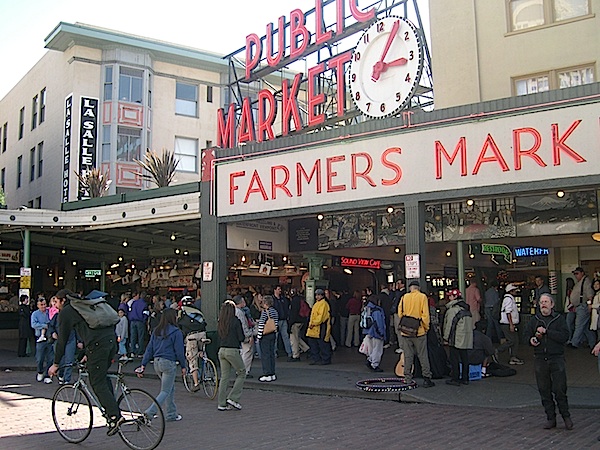
It all began in 1907 when a spike in onion prices led to a market within the city, where producers could come and sell their goods cheaply to the people of Seattle. There has been more than one unconscionable attempt to raze this valuable piece of downtown real estate, but the citizenry has always fought back to prevent it--you'll see 46,000 names in tiles underfoot for which donors paid $35 each--and in 1971 it was placed on the National Register of Historic Places. Today it is home to more than 200 year-round commercial businesses, 190 craftspeople and approximately 100 farmers who rent table space by the day, while 240 street performers and musicians ply their own craft. The Athenian Inn was only one of several scenes shot in the Market for the 1993 movie “Sleepless in Seattle.”
There’s very little you won’t find at the Market—the first Starbucks opened here and people line up to visit it as a tourist stop—so you walk by everything from superb fish and meat markets to Beecher’s Handmade Cheese; Britt’s Pickles; the quaint little Crumpet Shop; El Mercado Latino; Grandview Mushroom Farm; Mick’s Pappadum; Totem Smokehouse; and the irresistible Piroshky-Piroshky.
Seattle’s food scene is, in fact, very textured, with well-established restaurants like Tom Douglas’ Dahlia Lounge and a slew of newcomers every season that spice neighborhoods like Fremont, where there is a lot of new restaurant action. Some of the most enticing are run by the redoubtable Maria Hines, whose restaurants Tilth and Golden Beetle have now been joined by Agrodolce, an Italian place specializing in coastal cuisine, which seems a natural for a Pacific-bound city like Seattle.
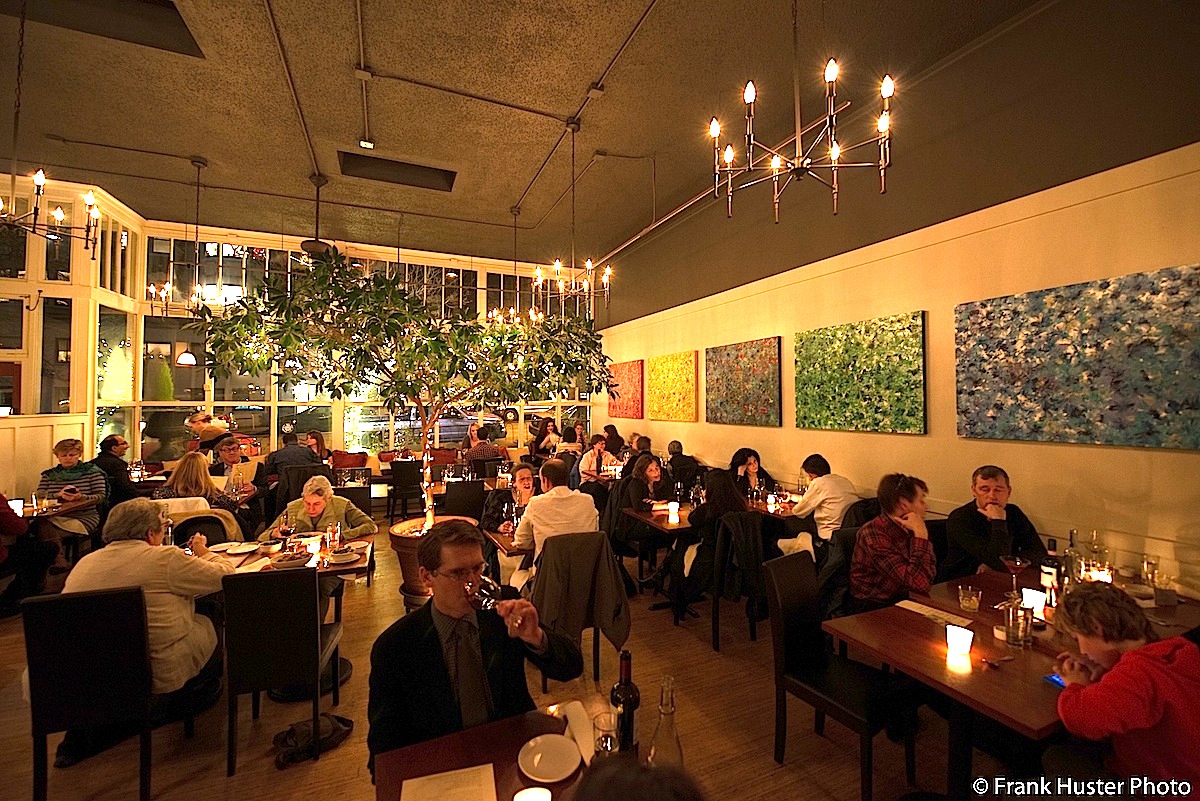 Agrodolce,
with just 43 seats inside—and right now it would be
nice to go al
fresco if the infamous Seattle rainfall doesn’t
interfere--is a very West Coast-amiable place with
soft banquettes you can lean back and sink into,
lighted trees, and abstract artwork by Eric Kolbe that
evokes vegetation. There are some fine
vegetarian and vegan dishes on the menu as well, from
spring onion soup with pickled garlic and a shot of
pecorino; a Pugliese-style burrata
cheese with baby beets
Agrodolce,
with just 43 seats inside—and right now it would be
nice to go al
fresco if the infamous Seattle rainfall doesn’t
interfere--is a very West Coast-amiable place with
soft banquettes you can lean back and sink into,
lighted trees, and abstract artwork by Eric Kolbe that
evokes vegetation. There are some fine
vegetarian and vegan dishes on the menu as well, from
spring onion soup with pickled garlic and a shot of
pecorino; a Pugliese-style burrata
cheese with baby beets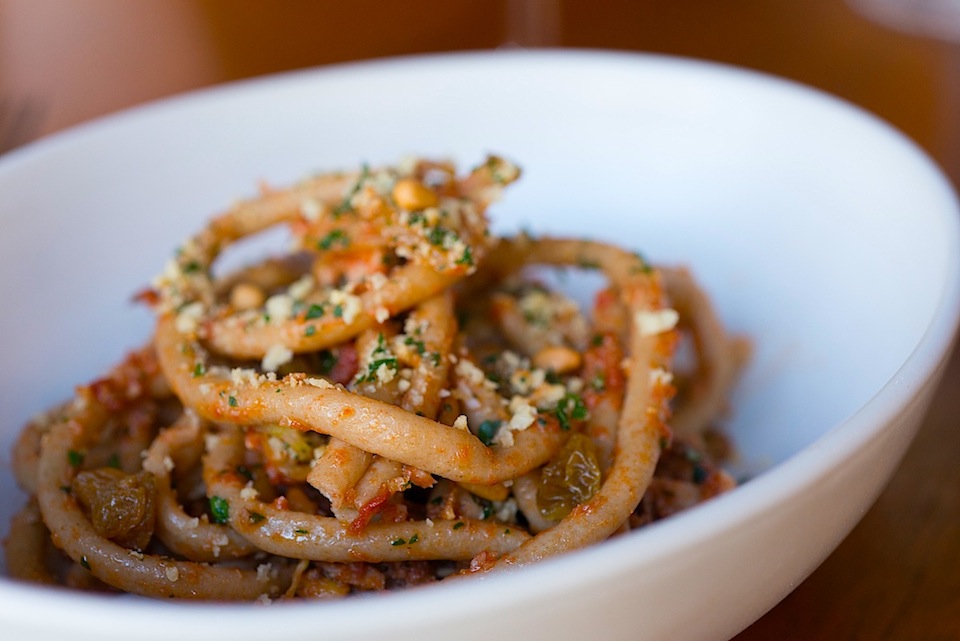 and a
sweet-sour honey gastrique; and cavatelli pasta
with
morels, peas, and sweet-sour gremolata.
(“Agrodolce” means sour-sweet,
so
it’s a leitmotif here.) Every pasta I tried, like the
tagliarini (right) were
perfectly cooked and impeccably sauced.
and a
sweet-sour honey gastrique; and cavatelli pasta
with
morels, peas, and sweet-sour gremolata.
(“Agrodolce” means sour-sweet,
so
it’s a leitmotif here.) Every pasta I tried, like the
tagliarini (right) were
perfectly cooked and impeccably sauced.
Hines, with exec chef Jason Brzozowy, offers fine seafood, too, like meaty St. Jude’s albacore tuna with garbanzo beans, bitter red radicchio, and tangy capers, while rabbit is slowly cooked with Marsala wine, farro grain and fava beans on the side, and leg of lamb is accompanied by lentils, artichoke and fresh oregano to perfume the dish and make that coastal connection plain.
You do not want to miss desserts here, which are as homey as they are delicious—steamed chocolate cake with mint, almond, and black currant; and a fat ricotta-stuffed cannoli with candied orange.
Agrodolce is open for lunch, brunch and dinner.
Dinner appetizers runs $3-$15, entrees
$17-$26. www.AgrodolceRestaurant.net
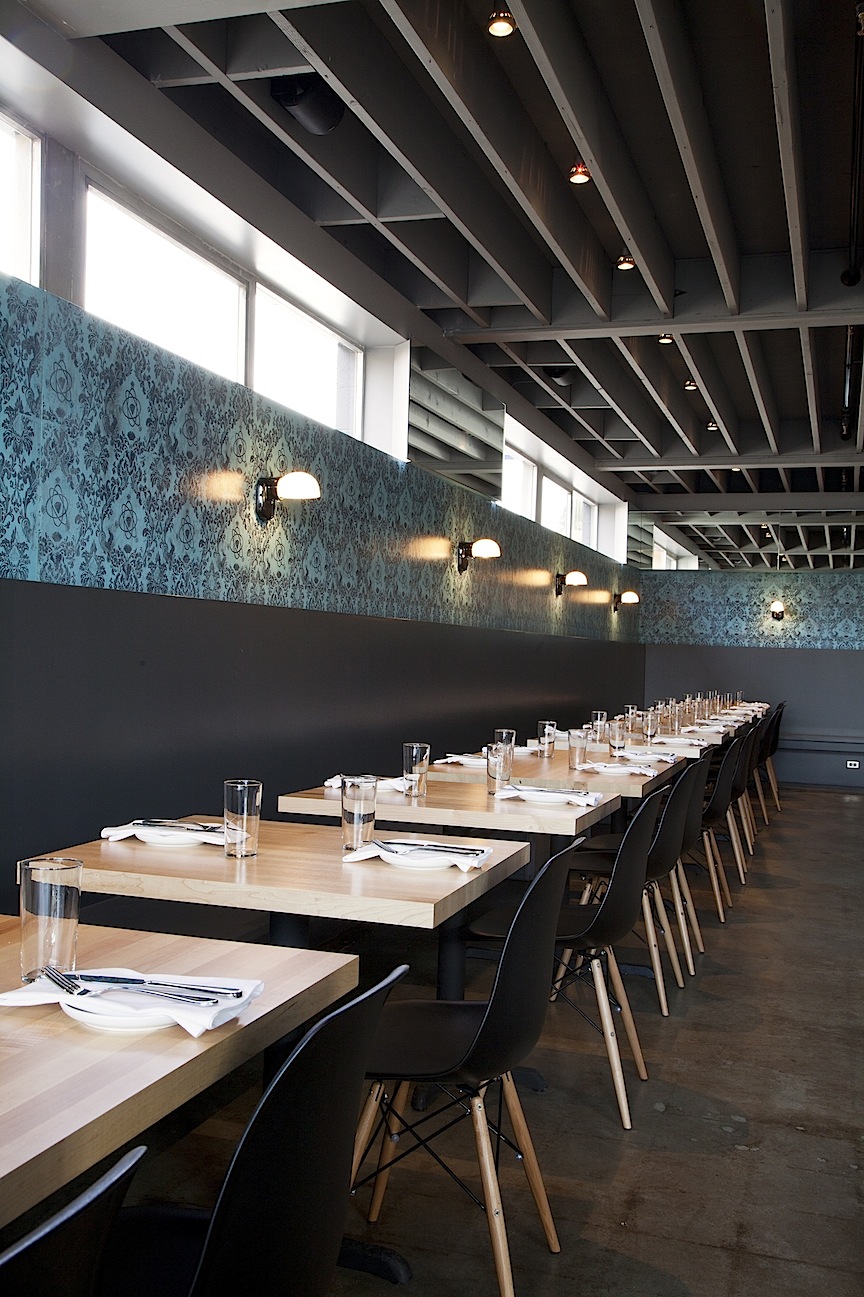 Also
out in Fremont is the new Joule,
actually a relocation and upsizing of the original,
opened in 2007 by husband and wife Rachel Yang and
Seif Chirchi, whose style combines Korean and American
flavors to wonderful effect, so you know the beef
is going to be very good.
Also
out in Fremont is the new Joule,
actually a relocation and upsizing of the original,
opened in 2007 by husband and wife Rachel Yang and
Seif Chirchi, whose style combines Korean and American
flavors to wonderful effect, so you know the beef
is going to be very good.
It’s a modestly sized
room with clean sharp lines, open kitchen, blue
filigreed tiles, concrete floor, and bare wooden
tables. The menu is precisely the length that a small
operation like this can handle, and prices, with apps
$9-$11 and main courses $16-$19 make sharing a capital
idea. 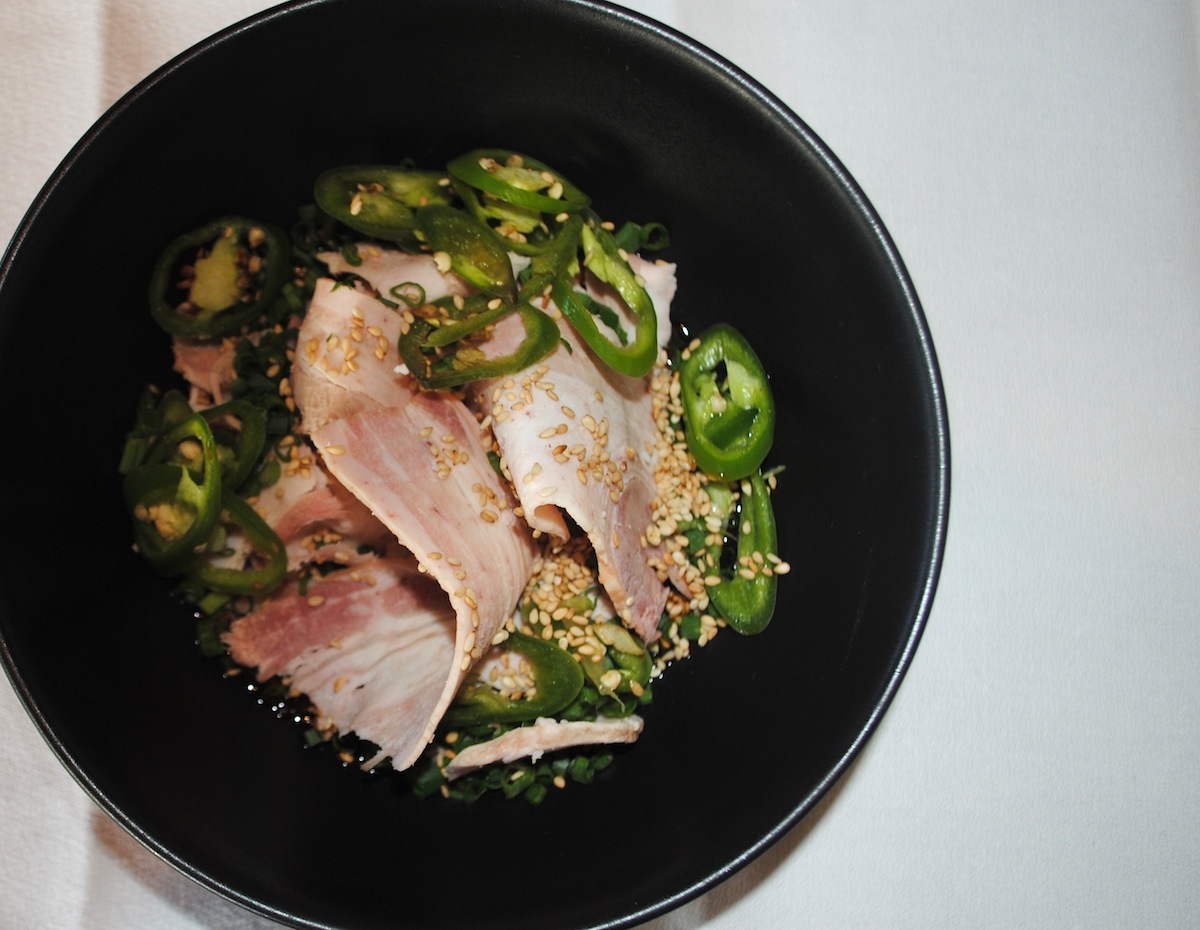 You might
begin with a spicy rice cake with spicier still chorizo and
pickled mustard greens; or the silky duck pastrami
with fried rice, pickled currants, and the hot Thai
relish called nam
prik. Manila clams glisten over
fennel-flavored pappardelle and an edge of salted black
beans in a rich marine broth, while the beef dishes
stand out both for their quality of meat itself and
for the way they are deftly marinated and assertively
seasoned: Korean-style short ribs come with hot, sour
grilled kimchi,
while beef royale comes with spicy pickled pearl
onions.
You might
begin with a spicy rice cake with spicier still chorizo and
pickled mustard greens; or the silky duck pastrami
with fried rice, pickled currants, and the hot Thai
relish called nam
prik. Manila clams glisten over
fennel-flavored pappardelle and an edge of salted black
beans in a rich marine broth, while the beef dishes
stand out both for their quality of meat itself and
for the way they are deftly marinated and assertively
seasoned: Korean-style short ribs come with hot, sour
grilled kimchi,
while beef royale comes with spicy pickled pearl
onions.
Non-meat dishes include a fleshy mackerel with a delightful green curry cilantro crust and sweet black currants. This being the Pacific Northwest, salmon has to be on the menu, here a lustrous sockeye with a spicy corn chow chow and a rich basil coconut cream.
The wine list is of considerable size for a small restaurant, with plenty of Pacific Northwest and California bottlings at very fair prices, with plenty of whites and reds under $50.
Joule is open for dinner only.
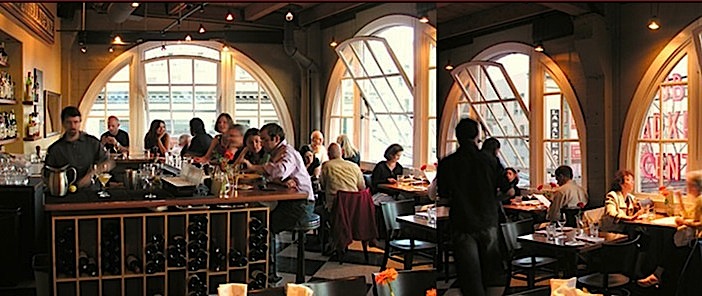 Located
on the third floor of Pike Place Market’s Corner
Building and newly expanded, Matt’s in
the Market is a place you don’t notice
from the street level but that everyone in Seattle
will happily point you to. The restaurant fits in so
perfectly with the atmosphere of the Market it feels
like a cherished old institution and a template for
many others that have grown up since in the city.
Matt’s does have lovely views of Elliottt Bay and the
teeming dash of the Market itself, with its iconic big
neon clock and sign across the street. The Matt in
question is Matt Janke, who opened here in 1996; today
the owner of the restaurant is Dan Bugge, who has
increased its size, comfort and wine cellar; the chef
is Shane Ryan.
Located
on the third floor of Pike Place Market’s Corner
Building and newly expanded, Matt’s in
the Market is a place you don’t notice
from the street level but that everyone in Seattle
will happily point you to. The restaurant fits in so
perfectly with the atmosphere of the Market it feels
like a cherished old institution and a template for
many others that have grown up since in the city.
Matt’s does have lovely views of Elliottt Bay and the
teeming dash of the Market itself, with its iconic big
neon clock and sign across the street. The Matt in
question is Matt Janke, who opened here in 1996; today
the owner of the restaurant is Dan Bugge, who has
increased its size, comfort and wine cellar; the chef
is Shane Ryan. 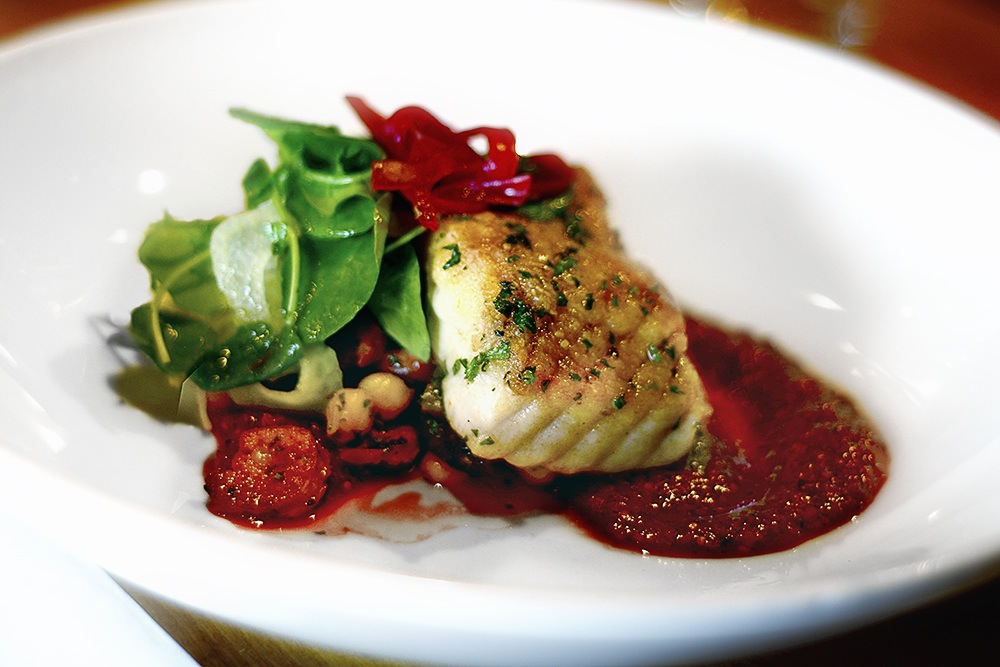
I ate at Matt’s at
lunchtime, but the dinner menu isn't radically
different in scope. So you want to begin with the
freshly made potato chips, seasoned with salt and
pepper and served with a hot bacon-caramelized onion
dip—the elevating of prole food to the sublime.
There’s a refreshing stone fruit salad and a chopped
Cobb salad with butter lettuce,  poached
chicken, deviled egg, avocado, bacon, bleu cheese
crumbles, and bleu cheese dressing, generous enough as
a meal all on its own.
poached
chicken, deviled egg, avocado, bacon, bleu cheese
crumbles, and bleu cheese dressing, generous enough as
a meal all on its own.
Certain dishes have led long lives on the menu, so you’ll always find steamed mussels and clams with chorizo, piquillo peppers, corona beans, charmoula, cava sparkling wine and fresh croutons. At lunch there’s an array of sandwiches to gorge on, like the pan-fried cornmeal-crusted catfish with sambal mayonnaise and shredded lettuce, on potato bread, and few people can resist not ordering the pork belly confit bánh mì (left) with pickled daikon radish & carrot, Fresno chilies, hoisin sauce, cilantro and sambal mayonnaise on a properly crisp baguette, once they've tried it. There’s also a “porkstrami,” decked out on rye with Gruyère, sauerkraut and thousand island dressing. By the way, the sandwiches come with soup or salad.
The sixteen dollars for Don & Joe’s lamb burger, piled high with goat’s cheese, bacon, herb aïoli and onion jam, on brioche with chickpea-sultana salad is worth every penny—one of the best burgers I’ve ever had.
For dessert, maybe the chocolate lime torte or the vanilla panna cotta? Then going shopping in the Market for dinner?
Matt’s is open for lunch and dinner, Mon.-Sat.
Dinner appetizers $14-$21, main courses $28-$48.
One of the most
delightful surprises of my recent trip was not the
object of my morning’s visit--the astounding Chihuly Garden and
Glass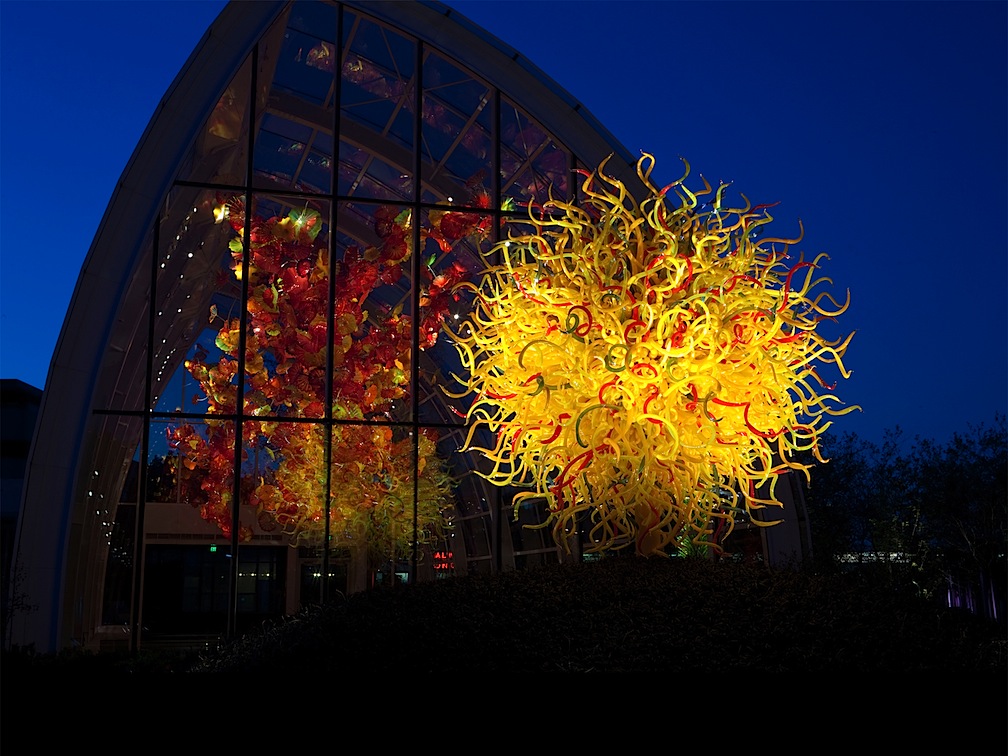 collection,
which is unique and uniquely beautiful. After
touring, I dropped into the Collections Café
within the walls of this stunning homage to glass in
every form.
collection,
which is unique and uniquely beautiful. After
touring, I dropped into the Collections Café
within the walls of this stunning homage to glass in
every form.
After wandering through the exhibition halls, with room after room of lighted glass and collections of photographs and crafts collected by global artist Dale Chihuly, you may need to sit down and let your mind settle. To do so in the Collections Café (below), which is itself done up in expanses of glass, with more collections of antique carnival chalkware, vintage accordions, radios, cameras, shaving brushes, and tin toys, is to increase your wonder.
 You hope the food will be
good: museum cafés in America have not
heretofore been known for their cuisine, though the
restaurants at MOMA in NYC and LACMA in Los Angeles
are testaments to how good they can and should be. The
Café here in Seattle more than exceeds
expectations under Chefs Jeff Maxfield and Ivan
Szilak, whose carte blanche to buy the best Washington
and Pacific ingredients underpins all their dishes,
which are simple, fresh and finely flavored.
You hope the food will be
good: museum cafés in America have not
heretofore been known for their cuisine, though the
restaurants at MOMA in NYC and LACMA in Los Angeles
are testaments to how good they can and should be. The
Café here in Seattle more than exceeds
expectations under Chefs Jeff Maxfield and Ivan
Szilak, whose carte blanche to buy the best Washington
and Pacific ingredients underpins all their dishes,
which are simple, fresh and finely flavored.
The wine list, a paltry three dozen bottlings, focuses on Washington and Oregon, and there is a good selection of craft beers, with dude names like Kaleidoscope Kolsch Ale, Chuckanut Pilsner, Whistling Pig Hefeweizen, Men’s Room Red Ale, and Scuttlebutt Blonde. As at Matt’s, the burger here is first rate, topped with red onion jam, bacon, Beecher’s Marco Polo cheese and garlicky aïoli. There is a tasty strawberry and goat’s cheese polenta cake with rainbow chard salad and bacon vinaigrette, and a pressed pork sandwich on ciabatta bread.
I kind of liked the meatballs here, served without pasta but with a charred tomato sauce on sourdough bread. The pasta dish to try is ravioli stuffed with red onions in an onion pistou with watercress salad and hazelnut vinaigrette. Plates can be ordered small or large, and I recommend sharing large plates of the seared prawns with smoky paprika, garlic, chili flakes, and a dash of Sherry on grilled sourdough. The grilled spare ribs here are terrific, too.
Open
for lunch Mon.-Fri., dinner nightly, brunch Sat.
& Sun. Starters $5-$15, main courses $11-$19.
Of course, one of the
main tourist attractions in Seattle is the Space Needle,
built in 1962—for a mere $4.5 million!--for that
year’s World’s Fair. Of course, it revolves—the
world’s second restaurant to do so--giving visitors an
Observation Deck view of Puget Sound, Mount Rainier,
the Cascade Mountains and the Olympics to the west.
is the Space Needle,
built in 1962—for a mere $4.5 million!--for that
year’s World’s Fair. Of course, it revolves—the
world’s second restaurant to do so--giving visitors an
Observation Deck view of Puget Sound, Mount Rainier,
the Cascade Mountains and the Olympics to the west.
Also here from the beginning is the Skycity Restaurant (below), which gives you a historic sense of a post-war period when such ideas were rampant, leading to other icons like Windows on the World in the original NYC World Trade Center.
Skycity 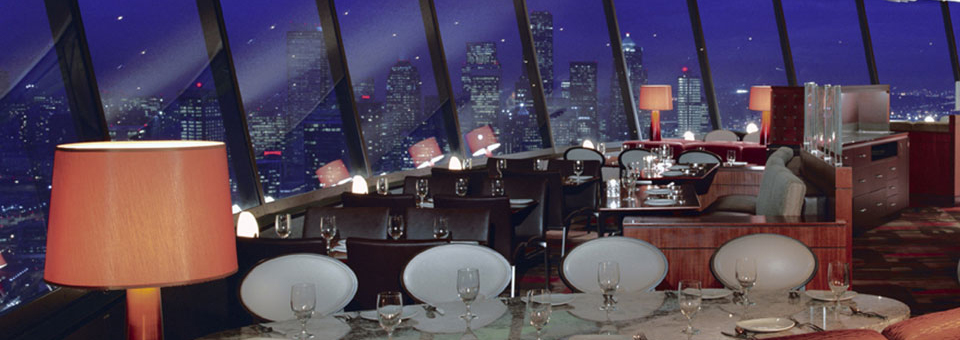 has not for a long while been regarded
as one of Seattle’s finer restaurants, but there has
been a good deal of work put into the public dining
room (it, too, revolves) and the menu to bring it up
to date. When I dined there this spring, the
food was sumptuous, focused on local ingredients, and
very, very expensive, with main course $39-$59, making
it it among the priciest menus in the U.S.
has not for a long while been regarded
as one of Seattle’s finer restaurants, but there has
been a good deal of work put into the public dining
room (it, too, revolves) and the menu to bring it up
to date. When I dined there this spring, the
food was sumptuous, focused on local ingredients, and
very, very expensive, with main course $39-$59, making
it it among the priciest menus in the U.S.
As has been said, you can’t eat the view, but, if you regard an evening in Skycity as something of a culinary and visual divertissement, you’ll have a pleasant enough evening, even if the service staff seems out of step. You’ll dine well if you choose simply, dishes like Dungeness crab cakes; ahi tuna crudo with wasabi dust, rose petal limeade, baby spinach and raspberries; and wild king salmon with spring onion nage, roasted sunchokes, and shaved asparagus-Dungeness crab salad.
Skycity is open form Lunch Mon.-Fri, brunch Sat.
& Sun., and Dinner nightly.
❖❖❖
NEW YORK CORNER
(Suburban Division)
by John Mariani
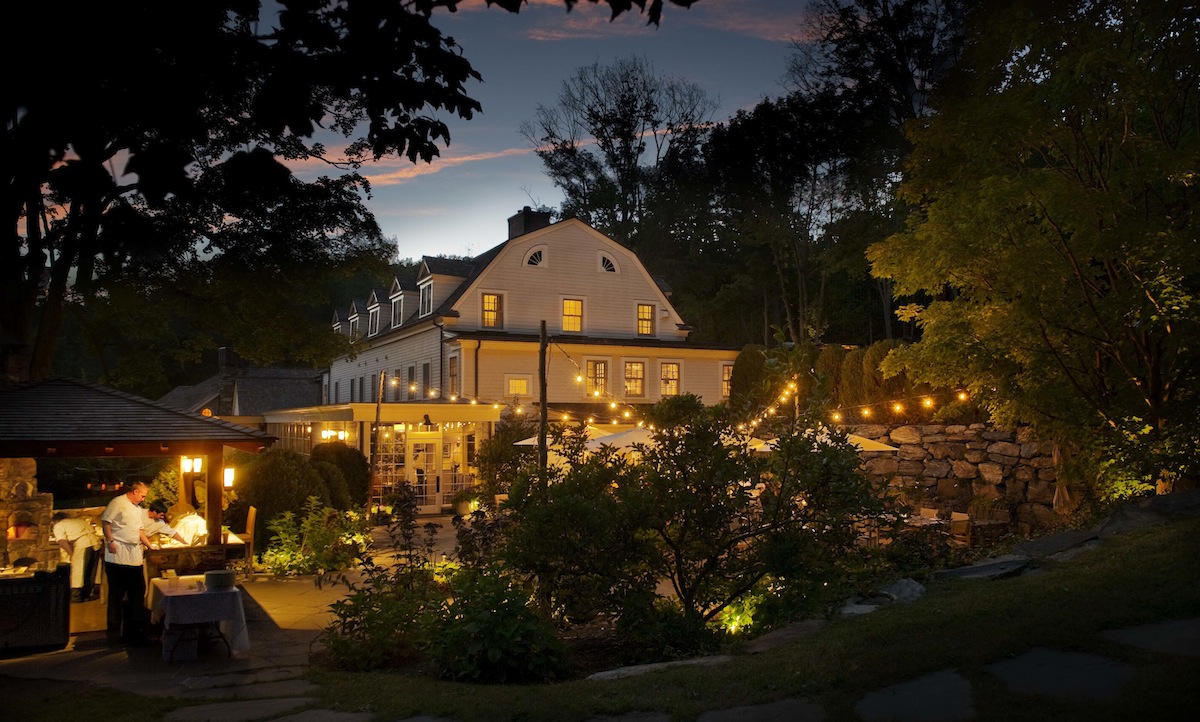 Bedford
Post Inn
Bedford
Post Inn
954 Old Post Road
Bedford, NY
914-234-7800
www.bedfordpostinn.com
The
Old
Post Road winds through upper Westchester County
through pretty towns like Bedford, and on a little
knoll alongside a bucolic stretch sits the Bedford
Post Inn and Restaurant. This is a labor of love for
actors Richard Gere and his wife, Carey Lowell (below), with
partner Russell  Hernandez, complete with eight rooms
and spa within an historic 19th century property
about an hour's drive from Manhattan. The Geres live
nearby and drop by the inn often, which has given
the enterprise a glamorous buzz.
Hernandez, complete with eight rooms
and spa within an historic 19th century property
about an hour's drive from Manhattan. The Geres live
nearby and drop by the inn often, which has given
the enterprise a glamorous buzz.
There are two places to dine here--the casual Barn and the more upscale Farmhouse; the former has 50 seats in a room with wood beam ceilings, tile floors, bare wooden tables, and an open kitchen and fireplace; upstairs, the Farmhouse has 75 seats, with bar (there is also outdoor seating now), and there is a Chef’s Table off to the side, seating twelve. The dining room is done in soft colors on wainscoting, with buffed wooden floors and well-spaced antique tables, set with breadbaskets, soft linens, fine stemware and good silverware. The lighting seems a bit lower than it used to be.
The wine list, under director Men Chang, has more than 2,500 bottles. The wine cellar can accommodate 24 guests.
Chef
Jeremy McMillan (below),
now here almost three years, has a fine kitchen
pedigree, having come from 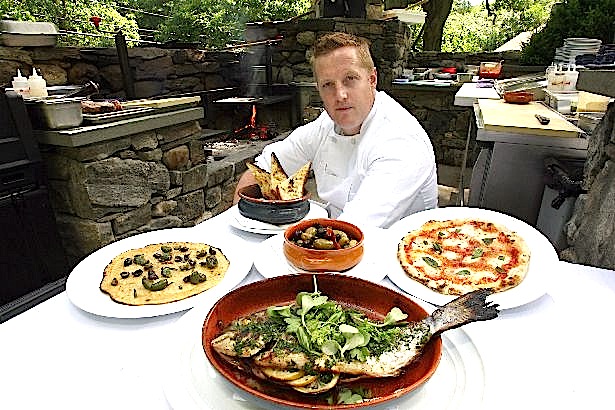 A Voce
Madison in NYC and before that Redd in Napa Valley.
He’s a big guy and he likes big flavors, proud
of his talent for smoking ingredients. Even
his breads—mixed crostini, bone marrow pizza, and
ricotta-stuffed calzone—have a wonderful smoky aroma.
A Voce
Madison in NYC and before that Redd in Napa Valley.
He’s a big guy and he likes big flavors, proud
of his talent for smoking ingredients. Even
his breads—mixed crostini, bone marrow pizza, and
ricotta-stuffed calzone—have a wonderful smoky aroma.
He also does what he calls “farmhouse tapas,” from hamachi crudo with apricot, vadouvan Indian spices and almond yogurt to oven-dried strawberries with whipped lardo and lovage. Even carrots get a char, served with Puglian mozzarella.
Pastas have become as American as any dish by now, and all I’ve tasted of McMillan’s have been outstanding, particularly the pappardelle with rabbit sausage and fava beans, and fagotelli with a richly satisfying parmigiano fonduta and a generous amount of chopped truffles.
I highly recommend the pork
chop with sweet grilled cherries and a dash of
balsamico vinegar for balance, while branzino with
salsa verde
and lemon is the best, simplest way to go for
seafood. There’s much more to the menu and
it’s all highly seasonal, so the vegetables and
fruits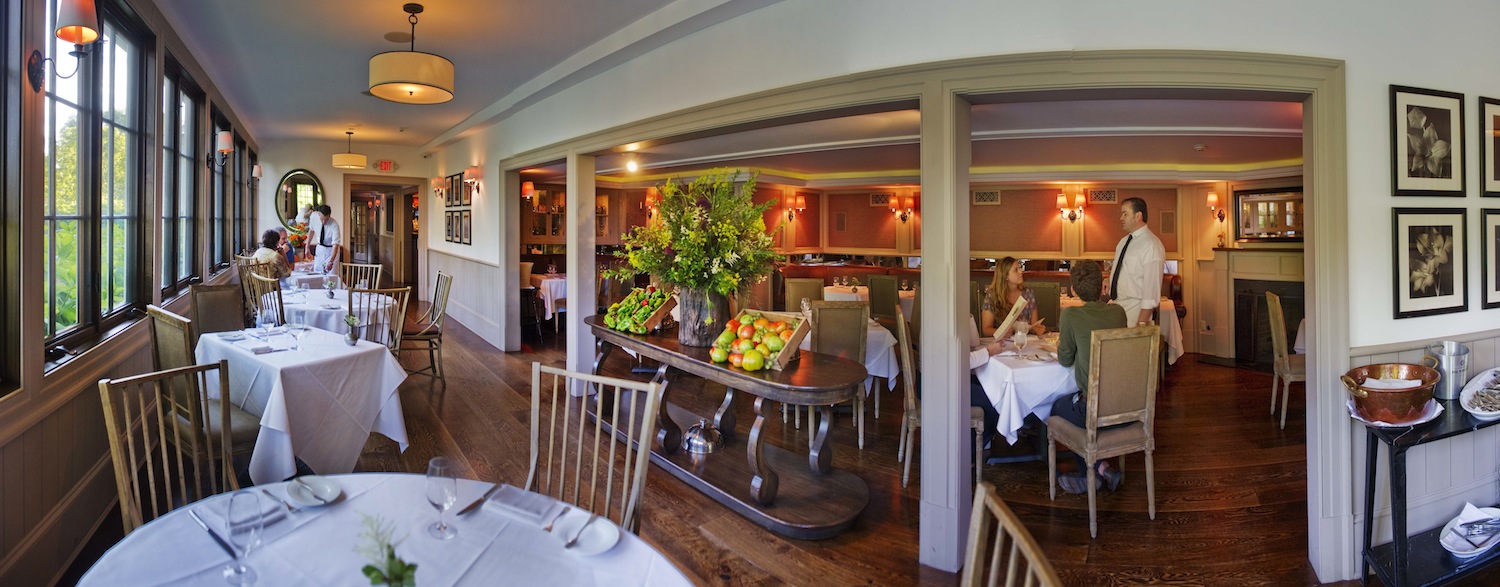 will change
on various dishes as befits a menu that now bespeaks
the bounty of summer.
will change
on various dishes as befits a menu that now bespeaks
the bounty of summer.
That goes for the desserts, which are rich in berries and cream, with little touches of summery herbs.
Samuel Johnson once
observed that “There is nothing which has yet been
contrived by man, by which so much happiness is
produced as by a good tavern or inn.” That is
still true today when an inn of the grace and
hospitality of the Bedford Post contrives to please
its guests in every possible way.
The Barn is open for breakfast Mon.-Fri., for lunch Mon.-Fri., for dinner Mon. and Tues., for brunch Sat. & Sun.; The bakery is open daily. The Farmhouse is open for dinner Wed.-Sun. Dinner appetizers run $10-$17, pastas and main courses $16-$35. There is a $75 tasting menu.
❖❖❖
KNOW WHAT YOU PAY FOR
by
Mort Hochstein
 European
winemakers entering the American market come
up against an off-putting forest of 52 states,
each with differing and often conflicting
regulations and demands. They can also be shocked by
the markups they see as their product progresses
from importer to wholesaler to retailer or
restaurant. The price of, say, a $12 bottle at
the winery often ends up on store shelves at about
$40, better than three times original cost. Those
price hikes are built into what is familiarly known
as the three-tier system and everybody along the
line takes a cut. In restaurants that might be hiked
up two or three times more.
European
winemakers entering the American market come
up against an off-putting forest of 52 states,
each with differing and often conflicting
regulations and demands. They can also be shocked by
the markups they see as their product progresses
from importer to wholesaler to retailer or
restaurant. The price of, say, a $12 bottle at
the winery often ends up on store shelves at about
$40, better than three times original cost. Those
price hikes are built into what is familiarly known
as the three-tier system and everybody along the
line takes a cut. In restaurants that might be hiked
up two or three times more.
That’s the basic route for imported wines. There are brokers, however, who keep prices at a lower level by arranging for wineries to sell directly to the distributor, eliminating one middle man, and the saving is usually reflected in the final selling price. In this instance, that $12 bottle might sell for about $30 on a retail shelf.
Some of the very best Italian wines, leaders such as Vietti, Marco Felluga, and Marchese Di Greve, come to these shores via Della Terra, which practices what the trade calls direct import, the practice described above. Brian Larkey, who created Dalla Terra Winery Direct, runs what I like to think of as a commune, but it’s a commune comparable to a gated neighborhood. He and the producers who comprise Della Terra vote on just who can join their community, and no one joins the group unless the members reach consensus. As agent for his commune, linking them directly to distributors, Dalla Terra charges a 15% fee, against the 40% traditionally charged by importers. “By cutting the importer’s fee,” Larky says, “we can lower the prices of our Italian wines between 20 and 30 percent.”
But there is really no easy way for the consumer to know that the wine passed through one fewer hand and should be cheaper, unless he is familiar with the producer. You’re not likely to find a retailer explaining the ins and outs of the three-tier system and the name of the importer or wine broker seldom appears on a wine label.
It is, then, beneficial to know the wines and be able to appreciate the value in comparison to other quality wines from the same provenance. In addition to the wines named earlier, the Della Terra roster includes Tenuta Sant’ Antonio, specializing in Valpolicella and Amarone; Tascante from Mt. Etna in Sicily; Selvapiani, a classic Chianti house; Poliziano, with wines from Montepulciano, Cortona, the Maremma and Tuscany; Masseria Liveli in Puglia; La Valentina from Abruzzo on Italy’s Adriatic coast; Inama, a Soave specialist now producing a full range of European varietals; Chiarli 1860, a historic Lambrusco producer; Boroli, known for Barolo and Dolcetto; and Badia A Coltibuono (above), one of the great houses of Tuscany. It is an assemblage of Italy’s most elite producers, but those firms also turn out a good number of wines under the $20 price mark.
Knowing
the
provenance of domestic wines can also give buyers a
bigger bang for their bucks. So many of the
California producers are relatively new to the field
and start off with huge expenses. Even those who
landed in Napa and Sonoma in the 1980s are still
paying off mortgages based on expensive land
purchases, as well as equipment and, in some cases,
new regulations that add to the cost of production,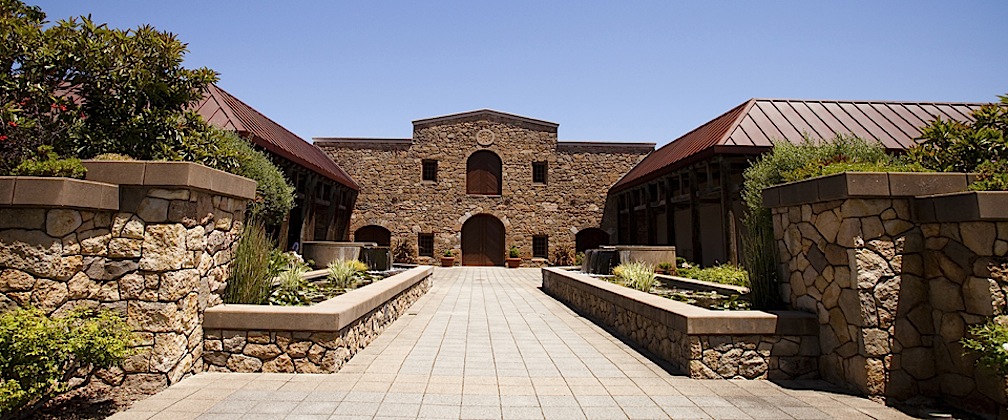 which earlier arrivals
may have escaped.
which earlier arrivals
may have escaped.
Markham (right) is a case in point, a winery known for quality wines at a reasonable price. It has been around since the start of the Napa Valley wine boom, yet it somehow flies under the radar, not getting the attention often focused on highly promoted Johnny-come-lately’s. The winery originated under the name of Laurent in 1879 and passed through several owners before being acquired by Bruce Markham in 1977. He snapped up vineyards in the early and mid-1970’s for about $5000 an acre, land now priced at about $350,000 an acre, and set out to produce reasonably priced wines. Markham's top-of-the-line Cabernets from estates in Yountville and Calistoga retail in the $50 range, but Markham also fields wines priced in the mid teens to mid twenties, wines of distinction rivaling much more expensive bottlings.
And then there is Markham’s Greystone line, value
priced at $11, with a fine ecological story
attached. Greystone, a historic stone winery
which once belonged to the Christian Brothers, now
houses the California branch of the Culinary
Institute of America. At inception, the CIA
planners were told by St. Helena officials
that the city wastewater facility
could not handle the volume of water the
school would exude from 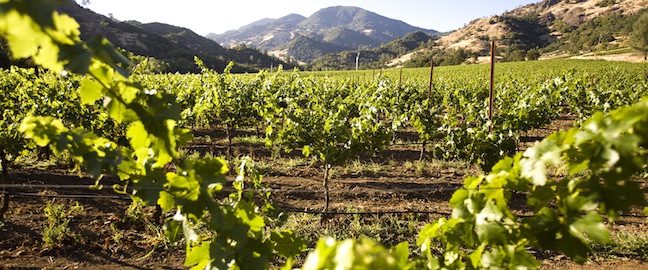 its kitchens,
dormitories, and restaurants.
Fortunately, the CIA engineer had also
been involved with Markham at its nearby facility,
and knew that its waste water system, which also
services Freemark Abbey Winery and the Wine Country
Inn, could accommodate effluent from the
culinary school.
its kitchens,
dormitories, and restaurants.
Fortunately, the CIA engineer had also
been involved with Markham at its nearby facility,
and knew that its waste water system, which also
services Freemark Abbey Winery and the Wine Country
Inn, could accommodate effluent from the
culinary school.
Once processed,
that clean water is used to drip dry irrigate nearby
vineyards operated by Freemark Abbey and the
Culinary Institute. Water for irrigation is a major
expense for vineyards and recycling the wastewater
has helped cut expenses for partners in the system
and as an added bonus, notes Markham CEO Bryan Del
Bondio, the school receives royalty payments on
sales of Markham’s Greystone wines.
❖❖❖

A study by the University of Mississippi found that “light arm-touching” by waitresses earned them 36 per cent more in tips. Calling customers by their name meant a 10 per cent better gratuity and that "drawing a smiley face on the bill" may net a 17 per cent windfall.

BUT WHAT
ABOUT THE CRUMBS?
"If
there is one point around which food snobbery
coalesces, it is authenticity. If it doesn’t seem
like it’s made by your mama from Chihuahua or your
nana from Nanjing, some people just don’t want to
eat it. And if there is a cuisine that draws
maximum ire in this regard, at least locally, it
is Mexican. Me, I’m not going to kick a
crunchy-shelled, ground beef-containing creation
out of bed for calling itself a taco.—Devra First,
“Fenway Mexican
restaurant Barrio Cantina lacks sizzle,” Boston Globe
(6/13/13).
❖❖❖
Any of John Mariani's
books below may be ordered from amazon.com.
 |
My latest book, which just won the prize for best book from International Gourmand, written with Jim Heimann and Steven Heller, Menu Design in America, 1850-1985 (Taschen Books), has just appeared, with nearly 1,000 beautiful, historic, hilarious, sometimes shocking menus dating back to before the Civil War and going through the Gilded Age, the Jazz Age, the Depression, the nightclub era of the 1930s and 1940s, the Space Age era, and the age when menus were a form of advertising in innovative explosions of color and modern design. The book is a chronicle of changing tastes and mores and says as much about America as about its food and drink.
“Luxuriating vicariously in the pleasures of this book. . . you can’t help but become hungry. . .for the food of course, but also for something more: the bygone days of our country’s splendidly rich and complex past. Epicureans of both good food and artful design will do well to make it their coffee table’s main course.”—Chip Kidd, Wall Street Journal.
“[The menus] reflect the amazing craftsmanship that many restaurants applied to their bills of fare, and suggest that today’s restaurateurs could learn a lot from their predecessors.”—Rebecca Marx, The Village Voice. |
"Eating Italian will never be the same after reading John Mariani's entertaining and savory gastronomical history of the cuisine of Italy and how it won over appetites worldwide. . . . This book is such a tasteful narrative that it will literally make you hungry for Italian food and arouse your appetite for gastronomical history."--Don Oldenburg, USA Today. "Italian
restaurants--some good, some glitzy--far
outnumber their French rivals. Many of
these establishments are zestfully described
in How Italian Food Conquered the World, an
entertaining and fact-filled chronicle by
food-and-wine correspondent John F.
Mariani."--Aram Bakshian Jr., Wall Street
Journal.
"Equal parts
history, sociology, gastronomy, and just
plain fun, How Italian Food Conquered the
World tells the captivating and delicious
story of the (let's face it) everybody's
favorite cuisine with clarity, verve and
more than one surprise."--Colman Andrews,
editorial director of The Daily
Meal.com. "A fantastic and fascinating
read, covering everything from the influence
of Venice's spice trade to the impact of
Italian immigrants in America and the
evolution of alta cucina. This book will
serve as a terrific resource to anyone
interested in the real story of Italian
food."--Mary Ann Esposito, host of PBS-TV's
Ciao
Italia. "John Mariani has written the
definitive history of how Italians won their
way into our hearts, minds, and
stomachs. It's a story of pleasure over
pomp and taste over technique."--Danny Meyer,
owner of NYC restaurants Union Square Cafe,
Gotham Bar & Grill, The Modern, and
Maialino.
|
 |
 |
 |
 |
 |
 |
 |
 |
 Everett Potter's Travel Report:
Everett Potter's Travel Report: 
 Eating Las
Vegas is the new on-line site for
Virtual Gourmet contributor John A. Curtas.,
who since 1995 has been commenting on the
Las Vegas food scene and reviewing
restaurants for Nevada Public Radio.
He is also the restaurant critic for KLAS
TV, Channel 8 in Las Vegas, and his past
reviews can be accessed at KNPR.org.
Click on the logo below to go directly to
his site.
Eating Las
Vegas is the new on-line site for
Virtual Gourmet contributor John A. Curtas.,
who since 1995 has been commenting on the
Las Vegas food scene and reviewing
restaurants for Nevada Public Radio.
He is also the restaurant critic for KLAS
TV, Channel 8 in Las Vegas, and his past
reviews can be accessed at KNPR.org.
Click on the logo below to go directly to
his site.

Tennis Resorts Online: A Critical Guide to the World's Best Tennis Resorts and Tennis Camps, published by ROGER COX, who has spent more than two decades writing about tennis travel, including a 17-year stretch for Tennis magazine. He has also written for Arthur Frommer's Budget Travel, New York Magazine, Travel & Leisure, Esquire, Money, USTA Magazine, Men's Journal, and The Robb Report. He has authored two books-The World's Best Tennis Vacations (Stephen Greene Press/Viking Penguin, 1990) and The Best Places to Stay in the Rockies (Houghton Mifflin, 1992 & 1994), and the Melbourne (Australia) chapter to the Wall Street Journal Business Guide to Cities of the Pacific Rim (Fodor's Travel Guides, 1991).


MARIANI'S VIRTUAL GOURMET
NEWSLETTER is published weekly. Editor/Publisher: John
Mariani.
Contributing Writers: Christopher Mariani, Robert Mariani,
John A. Curtas, Edward Brivio, Mort Hochstein,
Suzanne Wright, and Brian Freedman. Contributing
Photographers: Galina Stepanoff-Dargery,
Bobby Pirillo. Technical Advisor: Gerry McLoughlin.
© copyright John Mariani 2013
